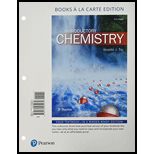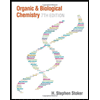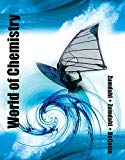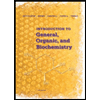
Introductory Chemistry, Books a la Carte Plus Mastering Chemistry with Pearson eText -- Access Card Package (6th Edition)
6th Edition
ISBN: 9780134557311
Author: Nivaldo J. Tro
Publisher: PEARSON
expand_more
expand_more
format_list_bulleted
Concept explainers
Question
Chapter 17, Problem 3E
Interpretation Introduction
Interpretation:
The term uranic rays is to be explained.
Concept Introduction:
The uranic rays were the name given to the radiation emitted by uranium containing crystals.
Expert Solution & Answer
Want to see the full answer?
Check out a sample textbook solution
Students have asked these similar questions
The two equations are forms of the Davies equation, used in thermodynamics for
activity coefficients:
ال
log Y₁ = -Az²
- 0,31
log
= Az²
- 0,31
1 + √Ĩ
1 + √√
k
These equations are consistent and imply that
Yi
=
Is this last equation correct?
k
The two equations are forms of the Davies equation, used in thermodynamics for
activity coefficients:
ال
log Y₁ = -Az²
- 0,31
log
= Az²
- 0,31
1 + √Ĩ
1 + √√
k
These equations are consistent and imply that
Yi
=
Is this last equation correct?
k
For the Davies equation, both expressions are correct:
log Y₁ = -Az²
√i
- 0,31
1 +
√
k
log-
= Az
- 0,31
k
1 + √Ĩ
Chapter 17 Solutions
Introductory Chemistry, Books a la Carte Plus Mastering Chemistry with Pearson eText -- Access Card Package (6th Edition)
Ch. 17 - Prob. 1SAQCh. 17 - Prob. 2SAQCh. 17 - Prob. 3SAQCh. 17 - Prob. 4SAQCh. 17 - Prob. 5SAQCh. 17 - Prob. 6SAQCh. 17 - Prob. 7SAQCh. 17 - Prob. 8SAQCh. 17 - Prob. 9SAQCh. 17 - Prob. 10SAQ
Ch. 17 - Prob. 1ECh. 17 - Prob. 2ECh. 17 - Prob. 3ECh. 17 - Prob. 4ECh. 17 - Prob. 5ECh. 17 - Prob. 6ECh. 17 - Prob. 7ECh. 17 - Prob. 8ECh. 17 - Prob. 9ECh. 17 - Prob. 10ECh. 17 - Prob. 11ECh. 17 - Prob. 12ECh. 17 - Prob. 13ECh. 17 - Prob. 14ECh. 17 - Prob. 15ECh. 17 - Prob. 16ECh. 17 - Prob. 17ECh. 17 - Prob. 18ECh. 17 - Prob. 19ECh. 17 - Prob. 20ECh. 17 - Prob. 21ECh. 17 - Prob. 22ECh. 17 - Prob. 23ECh. 17 - Prob. 24ECh. 17 - Prob. 25ECh. 17 - Prob. 26ECh. 17 - Prob. 27ECh. 17 - Prob. 28ECh. 17 - Prob. 29ECh. 17 - Prob. 30ECh. 17 - Prob. 31ECh. 17 - Prob. 32ECh. 17 - Prob. 33ECh. 17 - Prob. 34ECh. 17 - Prob. 35ECh. 17 - Prob. 36ECh. 17 - Prob. 37ECh. 17 - Prob. 38ECh. 17 - Prob. 39ECh. 17 - Prob. 40ECh. 17 - Prob. 41ECh. 17 - Prob. 42ECh. 17 - Prob. 43ECh. 17 - Prob. 44ECh. 17 - Prob. 45ECh. 17 - Prob. 46ECh. 17 - Prob. 47ECh. 17 - Prob. 48ECh. 17 - Prob. 49ECh. 17 - Prob. 50ECh. 17 - Draw the symbol for the isotope of lead that...Ch. 17 - Prob. 52ECh. 17 - Prob. 53ECh. 17 - Prob. 54ECh. 17 - Prob. 55ECh. 17 - Prob. 56ECh. 17 - Prob. 57ECh. 17 - Prob. 58ECh. 17 - Prob. 59ECh. 17 - Prob. 60ECh. 17 - Prob. 61ECh. 17 - Prob. 62ECh. 17 - Prob. 63ECh. 17 - Prob. 64ECh. 17 - Prob. 65ECh. 17 - Prob. 66ECh. 17 - Prob. 67ECh. 17 - Prob. 68ECh. 17 - Prob. 69ECh. 17 - Prob. 70ECh. 17 - Prob. 71ECh. 17 - Prob. 72ECh. 17 - Prob. 73ECh. 17 - Prob. 74ECh. 17 - Prob. 75ECh. 17 - Prob. 76ECh. 17 - Prob. 77ECh. 17 - Prob. 78ECh. 17 - Prob. 79ECh. 17 - Prob. 80ECh. 17 - Prob. 81ECh. 17 - Prob. 82ECh. 17 - Prob. 83ECh. 17 - Prob. 84ECh. 17 - Prob. 85ECh. 17 - Prob. 86ECh. 17 - Prob. 87ECh. 17 - Prob. 88ECh. 17 - Prob. 89ECh. 17 - Prob. 90ECh. 17 - Prob. 91ECh. 17 - 92. The fusion of deuterium and tritium produces J...Ch. 17 - Prob. 93ECh. 17 - Prob. 94ECh. 17 - Prob. 95ECh. 17 - Prob. 96ECh. 17 - Prob. 97ECh. 17 - Prob. 98ECh. 17 - Prob. 99ECh. 17 - Prob. 100ECh. 17 - Prob. 101ECh. 17 - Prob. 102ECh. 17 - Prob. 103QGWCh. 17 - Prob. 104QGWCh. 17 - Prob. 105QGWCh. 17 - Prob. 106QGWCh. 17 - Prob. 107DIA
Knowledge Booster
Learn more about
Need a deep-dive on the concept behind this application? Look no further. Learn more about this topic, chemistry and related others by exploring similar questions and additional content below.Similar questions
- k In Davies' equation log y₁ = log- log y₁ = log | = -Az² + ✓// k A is a constant that always equals 1.02. Correct? - 0,31arrow_forwardIndicate whether the equality is true Yi How is it obtained? k%arrow_forwardIndicate the relationship between the activity coefficient YA and the rate constant of a bimolecular reaction in solution k and the rate constant at infinite dilution ko.arrow_forward
- Describe the saline effect that occurs in solutions.arrow_forwardBriefly explain what the infinite dilution rate constant (k∞) consists of.arrow_forwardThe Davies equation corrects the Debye-Hückel limiting law for calculating the activity coefficient of an electrolyte in solution at relatively high concentrations. Mathematically, it is expressed as: log y₁ = -Az²? 1 + √Ĩ - 0,31) Is the formula correct?arrow_forward
- Differentiate between the concepts of "ionic salt effect" and "kinetic salt effect."arrow_forwardDifferentiate the concepts of “salino effect” and “salino kinetic effect”.arrow_forwardCome and compare the Bronsted-Bjerrum calculation, the Debye and Hückel calculation, and the Davies calculation.arrow_forward
- plz watch the youtube video (the title of this topic) by roxi H. she explains it step by step but i get the wrong answerarrow_forwardWriting the rate law implied by a simple mechanism To exit full screen, press and hold esc Suppose the decomposition of ozone proceeds by the following mechanism: step elementary reaction rate constant 1 →>> O3(9) O2(g) + O(g) k₁ 2 03(g) + O(g) → 202(g) k2 Suppose also k₁ »k2. That is, the first step is much faster than the second. Write the balanced chemical equation for the overall chemical reaction: Write the experimentally- observable rate law for the overall chemical reaction. ☐ rate = ☐ Note: your answer should not contain the concentrations of any intermediates. Express the rate constant k for the overall chemical reaction in terms of K1, K2, and (if necessary) the rate constants k-1 and K-2 for the reverse of the two elementary reactions in the mechanism. k = ☐ 000 18 ローロ Ar OOarrow_forwardDeducing a rate law from the change in concentration over time To exit full screen, press and hold esc A chemistry graduate student is studying the rate of this reaction: H2CO3(aq) → H₂O(aq) +CO₂ (aq) - She fills a reaction vessel with H2CO3 and measures its concentration as the reaction proceeds: time (milliseconds) [H2CO3] 0 0.0500 M 10. 0.0266M 20. 0.0181 M 30. 0.0138M 40. 0.0111 M Use this data to answer the following questions. Write the rate law for this reaction. Calculate the value of the rate constant k. Round your answer to 2 significant digits. Also be sure your answer has the correct unit symbol. rate ☐ x10 k = Х 000 18 Ararrow_forward
arrow_back_ios
SEE MORE QUESTIONS
arrow_forward_ios
Recommended textbooks for you
 General, Organic, and Biological ChemistryChemistryISBN:9781285853918Author:H. Stephen StokerPublisher:Cengage Learning
General, Organic, and Biological ChemistryChemistryISBN:9781285853918Author:H. Stephen StokerPublisher:Cengage Learning Organic And Biological ChemistryChemistryISBN:9781305081079Author:STOKER, H. Stephen (howard Stephen)Publisher:Cengage Learning,
Organic And Biological ChemistryChemistryISBN:9781305081079Author:STOKER, H. Stephen (howard Stephen)Publisher:Cengage Learning, World of Chemistry, 3rd editionChemistryISBN:9781133109655Author:Steven S. Zumdahl, Susan L. Zumdahl, Donald J. DeCostePublisher:Brooks / Cole / Cengage Learning
World of Chemistry, 3rd editionChemistryISBN:9781133109655Author:Steven S. Zumdahl, Susan L. Zumdahl, Donald J. DeCostePublisher:Brooks / Cole / Cengage Learning Introduction to General, Organic and BiochemistryChemistryISBN:9781285869759Author:Frederick A. Bettelheim, William H. Brown, Mary K. Campbell, Shawn O. Farrell, Omar TorresPublisher:Cengage Learning
Introduction to General, Organic and BiochemistryChemistryISBN:9781285869759Author:Frederick A. Bettelheim, William H. Brown, Mary K. Campbell, Shawn O. Farrell, Omar TorresPublisher:Cengage Learning Chemistry for Today: General, Organic, and Bioche...ChemistryISBN:9781305960060Author:Spencer L. Seager, Michael R. Slabaugh, Maren S. HansenPublisher:Cengage Learning
Chemistry for Today: General, Organic, and Bioche...ChemistryISBN:9781305960060Author:Spencer L. Seager, Michael R. Slabaugh, Maren S. HansenPublisher:Cengage Learning Chemistry & Chemical ReactivityChemistryISBN:9781337399074Author:John C. Kotz, Paul M. Treichel, John Townsend, David TreichelPublisher:Cengage Learning
Chemistry & Chemical ReactivityChemistryISBN:9781337399074Author:John C. Kotz, Paul M. Treichel, John Townsend, David TreichelPublisher:Cengage Learning

General, Organic, and Biological Chemistry
Chemistry
ISBN:9781285853918
Author:H. Stephen Stoker
Publisher:Cengage Learning

Organic And Biological Chemistry
Chemistry
ISBN:9781305081079
Author:STOKER, H. Stephen (howard Stephen)
Publisher:Cengage Learning,

World of Chemistry, 3rd edition
Chemistry
ISBN:9781133109655
Author:Steven S. Zumdahl, Susan L. Zumdahl, Donald J. DeCoste
Publisher:Brooks / Cole / Cengage Learning

Introduction to General, Organic and Biochemistry
Chemistry
ISBN:9781285869759
Author:Frederick A. Bettelheim, William H. Brown, Mary K. Campbell, Shawn O. Farrell, Omar Torres
Publisher:Cengage Learning

Chemistry for Today: General, Organic, and Bioche...
Chemistry
ISBN:9781305960060
Author:Spencer L. Seager, Michael R. Slabaugh, Maren S. Hansen
Publisher:Cengage Learning

Chemistry & Chemical Reactivity
Chemistry
ISBN:9781337399074
Author:John C. Kotz, Paul M. Treichel, John Townsend, David Treichel
Publisher:Cengage Learning
DIGESTER-35 | VITAMINS AND THEIR RELATED COENZYMES| GPAT | NIPER | PHARMACIST| DI; Author: GPAT DISCUSSION CENTER;https://www.youtube.com/watch?v=CGrdNYmho0s;License: Standard YouTube License, CC-BY